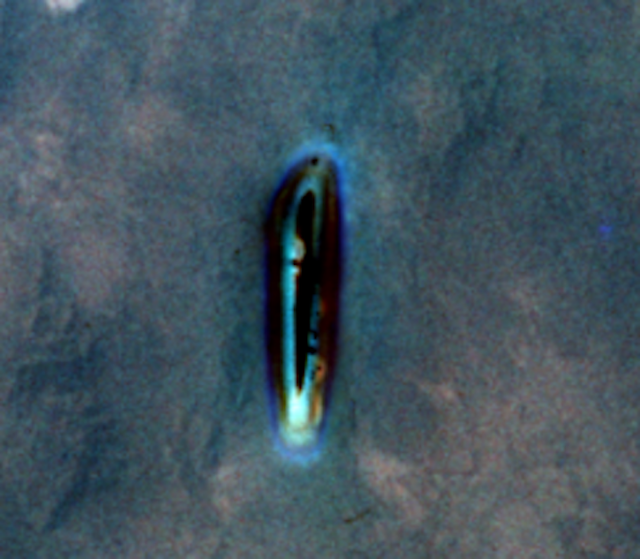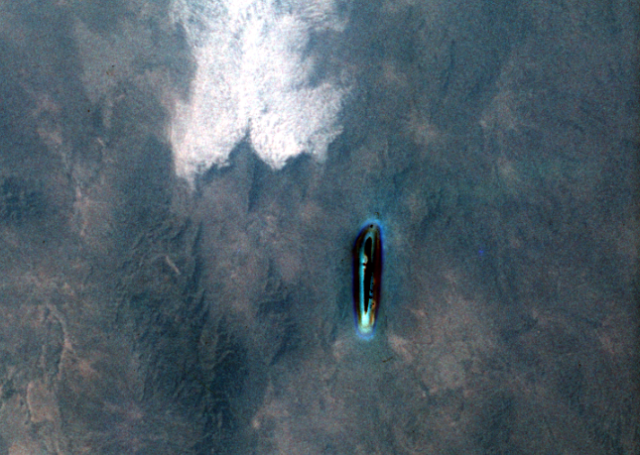Bright Blue Metallic UFO Photographed By Astronaut
Date of discovery: Oct 2013, but photo taken in June 1965
Location of discovery: Earths Orbit
James Alton McDivitt (Brig Gen, USAF Ret.) (born June 10, 1929) is a former NASA astronaut who flew in the Gemini and Apollo programs. He commanded the Gemini 4 flight during which Edward H. White performed the first US space walk, and later the Apollo 9 flight which was the first manned flight test of the Lunar Module and the complete set of Apollo flight hardware. He later became Manager of Lunar Landing Operations and was the Apollo Spacecraft Program Manager from 1969 to 1972.
McDivitt commanded the Gemini 4 mission with Edward H. White as his copilot. Launched on June 3, 1965, the mission lasted four days and made 66 orbits, allowing the United States to come close to the early space endurance record of five days set by the Soviet Vostok 5 flight. The first objective was to attempt the first space rendezvous with the spacecraft’s spent Titan II launch vehicle’s upper stage. This was not successful; McDivitt was unable to get closer than what he estimated to be 200 feet (61 m). Several factors worked against him. There were depth-perception problems (his and White’s visual estimates of the distance differed, variously longer or shorter than each other at different times). The orbital mechanics of rendezvous were not yet well understood by NASA engineers. Also, the stage was venting its remaining propellant, which kept pushing it around in different directions relative to the spacecraft.
McDivitt finally broke off the rendezvous attempt in order to save fuel and preserve the second, more important objective, which was for White to perform the first United States “space walk”. McDivitt controlled the capsule’s attitude and photographed White during the “walk”. The hatch on Gemini 4, through which White exited to make his walk, was prone to problems with the latch mechanism gears coming unmeshed, making it difficult to open and relatch the hatch. McDivitt had spent some time before the flight with a McDonnell engineer, improvising a technique of forcing the gears to mesh by inserting the fingers inside the mechanism. The hatch was difficult to open and also to relatch during the flight, but McDivitt was able to get it working both times, with his hands in his pressurized space suit gloves. If he had not been able to get the hatch latched after the space walk, both men would have most certainly been killed during re-entry.
On the second day, over Hawaii, while White was asleep, McDivitt happened to see an unidentified flying object, which he described as looking “like a beer can or a pop can, and with a little thing like maybe like a pencil or something sticking out of it.” He got a camera and took a few photographs of it, but did not have time to properly set exposure or focus properly. He believes that since it was visible to him, it must have been in an orbit close to that of his spacecraft, probably a piece of ice or Mylar insulation having broken off of it.
Word of the “UFO photos” reached the press by the time the flight splashed down, and one eager reporter waited for the Gemini 4 photos to be processed. He found one with a cluster of three or four images that looked like disc-shaped objects with tails, which became known as the “tadpole” photo. McDivitt has identified these as reflections of bolts in the multipaned windows. Gordon Cooper wrote in his memoirs that as far as he knows, it is the only officially reported account of a UFO in any of the Mercury, Gemini or Apollo missions.

James Alton McDivitt
McDivitt was selected as an astronaut by NASA in September 1962 as part of Astronaut Group 2. He was chosen as Command Pilot of Gemini 4, becoming the first US astronaut to command his first spaceflight. Only three other Gemini astronauts, from this group, were chosen to command their first flights: Frank Borman (Gemini 7), Neil Armstrong (Gemini 8), and Elliot See. (See was killed in the crash of a T-38 trainer jet three months before his Gemini 9 mission.) After Gemini, only two other rookies commanded their first flights: Gerald Carr (Skylab 4) and Joe Engle (Space Shuttle STS-2).
Scott C. Waring at UFO Sightings Daily












Recent Comments